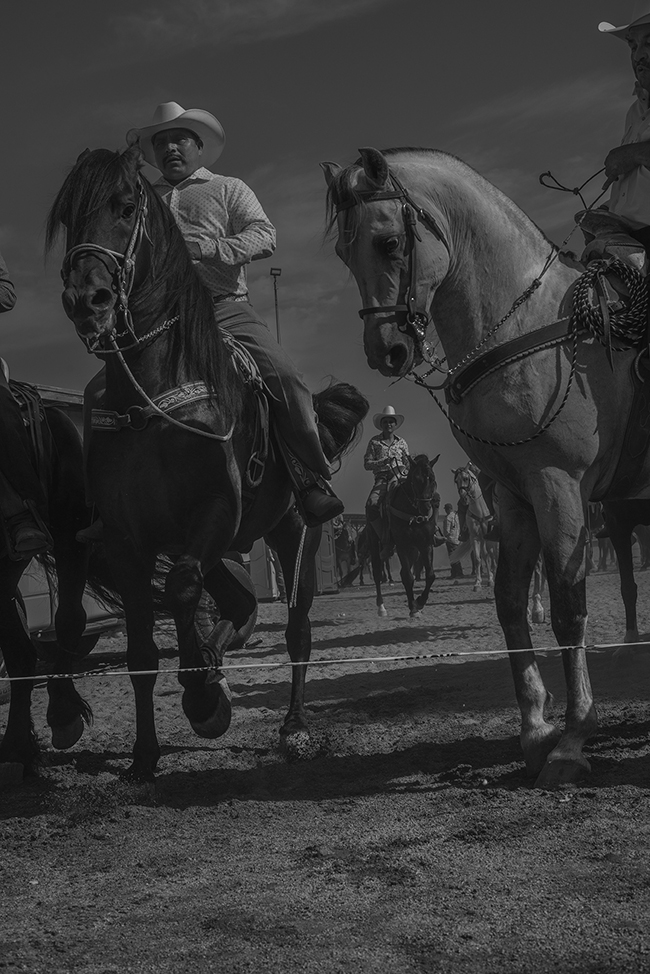Vera Saldivar de Lira, a visual artist and photographer originally from Aguascalientes, Mexico, works out of Southern California and New York City. Her journey through creative practices began with a solid foundation in architecture, which now underpins her explorations of space, materiality, and social relationships through the visual arts. Vera’s perspective is distinct; she is not simply documenting or photographing space. Instead, she investigates the deep-seated, often unspoken connections between people and the spaces they inhabit, focusing on how these interactions reflect broader social and political structures.

Saldivar’s background in architecture lends an analytical approach to her work. Her fascination with how individuals perceive and use space under capitalist frameworks shapes her imagery. Vera questions how capitalism affects an individual’s sense of belonging and alienation within urban and rural landscapes—a theme that resonates throughout her projects. Her academic achievements, including a Creative Practices certificate from the International Center of Photography (ICP) and an MFA in Advanced Photographic Studies from ICP/Bard College, underscore her rigorous approach. During her studies, she received the Arnold Newman Scholarship and a Director’s Fellowship, awards that reflect her keen ability to blend creative practice with critical inquiry. Vera was also named one of Artpil.com’s ’30 under 30′ photographers to watch in 2022, and her work has been featured in publications like Aint Bad, Zone Magazine, and Museé Magazine.
One of her ongoing projects, Entre Dos Tierras, takes a specific look at the Inland Empire in Southern California, a region undergoing rapid change. The Inland Empire has long been a home for Mexican immigrants and Chicano communities, many of whom brought with them the ranchero traditions of rural living and equestrian culture. Drawn initially by affordable land prices, these communities built a lifestyle reminiscent of rural Mexico, with many families relying on the land for both personal fulfillment and, in some cases, a living. But the Inland Empire has also attracted attention from multinational logistics companies, thanks to its access to major rail and freight routes. Companies like Amazon and FedEx have planted massive warehouse facilities in the area, shifting the landscape and culture. What was once agricultural land has become crowded with concrete warehouses, often leaving the ranchero communities feeling alienated and forced to confront the encroachment on their way of life.
Entre Dos Tierras reflects on these changes by documenting the spread of warehouses and the rise of industrial gentrification in the Inland Empire. Vera’s images capture the effects on both the land and the people, offering an intimate view of how these communities are navigating the pressures of corporate expansion. Through this visual archive, she highlights the environmental and social issues at play, including worsening air quality and restricted public services, which come as an aftereffect of increased industrialization. Vera’s work goes beyond observation; she captures the resilience of the ranchero communities, who, despite the odds, are making concerted efforts to preserve their heritage. From organizing protests to creating fundraising events, these communities are pushing back, seeking to protect their land, traditions, and the very fabric of their culture.
In addition to its human focus, Vera’s work also invites viewers to think about the value and production process of images. She’s deeply interested in how images are created, consumed, and understood within capitalist frameworks. Through her installations and spatial interventions, Vera critiques the process of image-making itself, asking how the material conditions and social relationships around us influence how we interpret visual art. By doing so, she challenges viewers to reconsider what they see and understand the layers of context that shape an image’s meaning.
Vera has also received Curious Publishing’s BIPOC + Queer Publishing Fund. This support has opened new avenues for her work, allowing her to expand her exploration of identity and space in ways that resonate with diverse audiences. Her upcoming publication promises to continue her practice of merging the personal with the political, using the medium of photography as both documentation and inquiry.
In a world where rapid urban expansion often disregards local culture, Vera Saldivar de Lira’s work stands as a reminder of the intricate ties between land, heritage, and community. She captures the quiet struggle of these communities as they fight against being erased from a landscape they have helped shape. Through her lens, Vera doesn’t just document change; she honors the people living in its wake, giving voice to their concerns and resilience. Her art captures the complexities of space under capitalist pressures and prompts viewers to question how we all fit within the spaces we call home.

